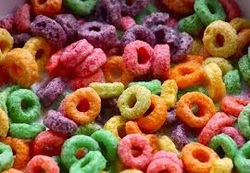 Zombie Jack!
Zombie Jack! Then, the second mention was the day after Halloween. As you can see, Jack was a zombie, complete with scary, bloody make-up. Unfortunately, the red seemed to stain his skin so badly that it looked like his eyes, nose, and mouth were all still bleeding the next day at school!!! Someone told me I should be careful, that he may be allergic to red #40. I thought, "Hmmmm... I thought that was a food allergy! Now I'm all confused!"

There really isn't an allergy to the dye, per se.
Research is still being done to pinpoint the causes behind red dye sensitivity. While we think of an allergy as an immunological response, those people (usually children) who have a "response" to ingesting red #40, specifically symptoms mimicking ADHD, temper tantrums, and severe irritability. There is a great article explaining this on Disney Family.
The red used in face paint is NOT the same as what is in food dye.
I thought it was interesting that people were telling me Jack could be allergic to the dye in his face paint, just like those who eat dyed food. This myth was dispelled on the FDA website along with tons of other interesting information about the additives and coloring used in our foods.
Red Dye #40 does NOT occur naturally.
Don't worry if you love your strawberries, cherries, and cranberry juice. Red #40 is a man-made compound added to mainly processed foods. So, if you are eating a whole foods diet, your exposure to dyes will be lessened.
There is still a lot more to learn.
Almost every site I came to discussed the need for ongoing research into this field. While food coloring has been approved since 1971, professionals are still evolving their opinions on added food compounds.
Bottom line: If you or your child has noticeable personality or behavior issues after consuming red #40, talk to your doctor. Avoid processed, manually colored foods, and don't fear! While there is still emerging data, this type of "allergy" is gaining wider acceptance. Here are a few more links I found that may be able to help you out: The Feingold Program Red Dye 40

 RSS Feed
RSS Feed